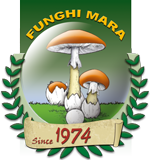The food value of mushrooms Mushrooms of interest: Cultivated white mushroom, Shaggy ink-cap, Shiitake, Oyster mushroom, Gigant stropharia, Truffle
The mushroom is used today in cooking for its taste and delicate flavour and is often considered more a refined touch to a dish than a proper food. Mushrooms have not yet become a food for constant and everyday consumption because of the lack of information on the part of the consumer, who considers it only a complementary food. However the mushroom should be given more importance in cooking, since it has a high food value and is easy to digest.
The mushroom is mainly made up of water (92%), proteins (3-4%) and carbohydrates. We may thus see that mushrooms have a low fat content (only 0.25% of their weight) and are rich in protein, thus making them ideal for a diet requiring low-calorie foods. The calorie value of mushrooms is in fact close to 250 calories per kilo.
Of course the protein content varies according to the different species and varieties and is also determined by the age of the mushroom. Cultivated mushrooms (e.g. the field mushroom) have a protein content of 3-4%. Young mushrooms have a higher protein content than older ones.
Of course the proteins provided by mushrooms alone are not enough to provide a rational diet. However, according to "Hayes" and "Madded", it seems that the edible proteins in mushrooms are some of the most important in the vegetable kingdom.
Mushrooms are very easily digested, with a digestibility of around 80%. This makes them ideal for children and the elderly.
As regards food value, mushrooms have a high mineral salt content, with a large proportion of phosphorus, manganese, potassium, iron and calcium, besides containing a fair amount of vitamins, particularly vitamin C and the B complex. The protein content of mushrooms is proportionally higher than that of all other vegetables and is the equivalent of that of pulses.
If we want to make the most of the mushroom as a food in itself, besides its food value, we must consider its cost with respect to that of other vegetables.
If we compare the different contents in food elements, salts and vitamins of the most common edible vegetables with those of mushrooms, we can see that with an equivalent food value, the mushroom is one of the most economical products. This just goes to show that it is not true that mushrooms are only found at the tables of the wealthy!
Besides the "quick effect" food value, we should also mention the long-term advantages of a diet which regularly includes mushrooms.
Medical research has shown that dietary fibres are an essential part of the healthy diet. 100 gr. of mushrooms contain more fibre than a slice of wholemeal bread, not to mention fewer calories! It is well known that many of the foods we eat contain a lot of salt, particularly sodium which increases blood pressure. Mushrooms contain a lot of potassium and very little sodium and therefore make ideal nutrition for those who want to reduce their sodium intake or eat healthily.
Many authors attribute important medicinal properties to mushrooms.
Pleurotus ostreatus (oyster mushroom), for example, lowers the level of cholesterol and triglycerides besides helping to protect against tumours, inflammation and viruses.
Coprinus comatus (shaggy cap) appears to contain substances which lower the amount of blood sugar and have an anti-diabetic effect. Morchella (morels) can be used against gout. Auricola judae has anti-inflammatory properties for eyes and throat. Stropharia is rich in the vitamin B complex and contains 10 times as much niacin than cabbages and cucumbers. Niacin is known to have positive effects on the nervous system and on the organs of the digestive tract. Stropharia also contains vitamin PP. Flammulina velutipes is considered to have anticarcinogenic properties. The truffle is rich in proteins with 9 gr. out of 100 and also contains vitamin C, while the Chanterelle contains Vitamin A.
However the miracle mushroom seems to be Shii-take. This mushroom contains Eritadenine which reduces the amount of cholesterol in the blood plasma. An intake of 300 gr. per day for 7 days reduces the cholesterol content in bile. What is more, Shii-take has antiviral properties against flu and poliovirus and obstructs the growth of cancer cells; its gills are rich in vitamin B1 and B2; and it contains ergosterin which forms vitamin D and the fruit vitamins B12 and D2. Last but not least, in Japan it is also considered to have aphrodisiac powers.
The button mushroom contains fibres and enzymes like chitosan, which helps control weight by inhibiting the intestinal absorption of excess fats, as well as vitamins, mineral salts, potassium, phosphorus, manganese, iron and calcium.
Giuseppe Lanzi
Società Agricola Funghi Mara | info@funghimara.it | Tel 0039 051 892049 - 0039 051 872350 | VAT number: 04045081207
© 2025 Funghi Mara. All rights reserved.







